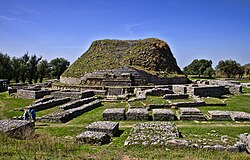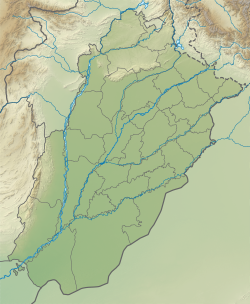
Taxila
City in Punjab, Pakistan / From Wikipedia, the free encyclopedia
Dear Wikiwand AI, let's keep it short by simply answering these key questions:
Can you list the top facts and stats about Taxila?
Summarize this article for a 10 year old
Taxila or Takshashila (Punjabi and Urdu: ٹيکسلا; Sanskrit: तक्षशिला, romanized: Takṣaśilā; Pali: Takkasilā; Ashokan Prakrit: 𑀢𑀔𑀲𑀺𑀮𑀸, Takkhasilā; Ancient Greek: Τάξιλα, romanized: Táxila)[2] is a city in the Pothohar region of Punjab, Pakistan. Located in the Taxila Tehsil of Rawalpindi District, it lies approximately 25 kilometres (16 mi) northwest of the Islamabad–Rawalpindi metropolitan area and is just south of the Haripur District of Khyber Pakhtunkhwa.
Taxila
ٹيکسلا | |
|---|---|
 | |
| Coordinates: 33°44′45″N 72°47′15″E | |
| Country | |
| Province | |
| Division | Rawalpindi Division |
| District | Rawalpindi District |
| Tehsil | Taxila Tehsil |
| Elevation | 549 m (1,801 ft) |
| Population (2017) | |
| • Total | 85,000[1] |
| Time zone | UTC+5:00 (PKT) |
| Postal code | 47080 |
| Dialing code | 596 |
| Criteria | iii, vi |
| Designated | 1980 |
| Reference no. | 139 |
Old Taxila was for a time the capital city of ancient Gandhāra, situated on the eastern shore of the Indus River—the pivotal junction of the Indian subcontinent and Central Asia;[3] it was founded around 1000 BCE. Some ruins at Taxila date to the time of the Achaemenid Persian Empire. In 326 BCE, the city was conquered by Alexander the Great who gained control of the city without a battle since the city was immediately surrendered to the Macedonian Empire. This was followed successively by the Maurya Empire, the Indo-Greek Kingdom, the Indo-Scythians, and the Kushan Empire. Owing to its strategic location, Taxila has changed hands many times over the centuries, with many polities vying for its control. When the great ancient trade routes connecting these regions ceased to be important, the city sank into insignificance and was finally destroyed in the 5th century by the invading Hunas. In mid-19th century British India, ancient Taxila's ruins were rediscovered by British archaeologist Alexander Cunningham and extensively excavated by Sir John Marshall. In 1980, UNESCO designated Taxila as a World Heritage Site.[4]
By some accounts, the University of ancient Taxila is considered to be one of the earliest universities or education centre in South Asia.[5][6][7][8][9] Other scholars do not consider it to have been a university in the modern sense, in that the teachers living there may not have had official membership of particular colleges, and there did not seem to have existed purpose-built lecture halls and residential quarters in the city. In a 2010 report, the Global Heritage Fund identified Taxila as one of 12 worldwide sites that were "on the verge" of irreparable loss and damage, citing insufficient management, development pressure, looting, and armed conflict as primary threats.[10] However, significant preservation efforts have since been carried out by the Pakistani government, which has resulted in the site's recategorization as "well-preserved" by different international publications.[11] Because of the extensive preservation efforts and upkeep, Taxila is one of Punjab's popular tourist spots, attracting up to one million tourists every year.[11][12]

